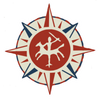About maps
Collecting antique maps
People own maps for various reasons. Maps are objects of cartography heritage, sources of historical data, and objects of alternative investment. Of course people also purchase maps for aesthetic reasons – to decorate their homes and offices, or to give an impressive gift to a business partner.
Any collection of maps always starts with the first map. Usually only time shows if mere interest will become a passion. And if a set of maps will turn into a collection. On the other hand, limited resources should not be an obstacle to purchasing a first map. Since a set of even dozen yet well-chosen maps can become an object of pride for the owner and a source of pride for the family.
The common axes to form a collection are time and location. Specialists recommend defining clearly the time and geographical latitude of interest. Most would agree that a Lithuanian map of the 17th century will hardly fit with a 19th century sea chart of North Africa.
Usually people choose maps of geographic latitudes that are close to them. And Europe is enough diverse for variations. Considering the colourful history of Central East Europe, one can also choose for example maps of the Grand Duchy of Lithuania, the Republic of Two Nations, the Eastern Europe or the Baltic Sea Region. We have strived to offer maps that reflect the historical connections of our region.
Approach us and we will consult you on the map you want personally or as a gift, considering the interests of the future owner. We are enthusiasts who believe in the cultural value of this hobby, and who enjoy communicating to anyone who enters the world of old maps.
Old and antique map
Old map is a map the information on which no longer reflects reality (e.g. changed state borders), thus the map that to have lost its initial function, i.e. the representation of space.
Items are said to be antiquarian when over one hundred years. Especially those maps made using old technologies, i.e. wood/metal drawings pressing on special paper, are called antique maps. The technology dates to the end of the 15th century, several decades after Mr.Gutenberg invented the book printing press around 1440.
So the answer to whether it is possible to find maps used by Lithuanian Grand Duke Vytautas or King of Poland Jogaila is unfortunately negative.
Printing works became faster and cheaper after Mr.Zenefelder invented the lithograph in 1796 and Mr.Koenig invented the printing machine in 1810. Printing costs decreased and volumes printings increased drastically. This is why maps made using modern technologies are considerably cheaper than antique ones – their print volumes were low and each was drawn by hand. Without doubt, the quantity of such maps remaining is very limited.
And yet it does not mean that old maps are boring or worthless. The value of each map is determined by various factors: rarity, aesthetic appeal, quality of a certain map, etc.
The antique maps had been sold in two way: as one separate issue (maps of very large size, e. g. the first editions of the map of Grand Duchy of Lithuania by Duke M. K. Radvila Našlaitėlis ), or combined into atlases. The later the map was taken from the old atlas and went to market as separate sheet, the better its expected quality. Atlases are being fragmented for various reasons to the present day, so it is not unusual to see an antique map of perfect quality. So the quality of a map is determined by keeping the conditions of atlas itself or separated map.
During ages atlases were very expensive, as they are today – the price for classical one can be as high as 100 000 EUR. Atlas Maior (1662), a twelve volumes atlas of 600 maps by cartographer Johannes Blaeu is called the king diamond: it was the most expensive publication in the 17th century, so it was presented as a diplomatic gift from the Netherlands to the Sultan of Turkey and the Holy Roman Emperor.
So atlases and maps were carefully and safely kept in the libraries of aristocratic manors and universities, where they were protected against the flow of time and hardships, hence many maps are well-preserved to the present day.
Maps of Lithuania and surrounding countries
Without going into long and interesting discussions about the change of essence of the word “Lithuania” over time, we suggest becoming acquainted with the maps of Lithuania and neighbouring regions at the Lithuanian National Library’s excellent publication Lithuania in Maps (the most comprehensive edition was issued in 2011.)
